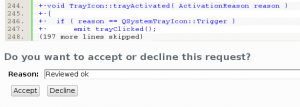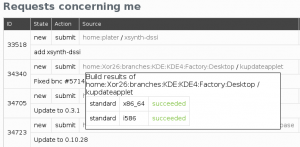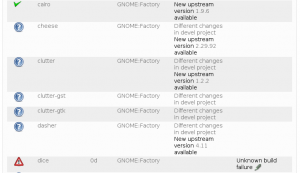Last weekend, I was boosting at Chemnitzer Linux Tage where we ran openSUSE booth with Jan Weber, Kai-Uwe Behrmann and Sirko Kemter. Jan and Sirko already wrote reports at their blogs, so I’ll add just some personal thoughts and remarks.
It all started on Friday at the Greek restaurant. There was about ten of us, including all the guys mentioned above, invis-server people and others (sorry, I suck at remembering names). We had nice evening with some greek food (surprisingly), German beer and free ouzo refill. Yes free. Caused me troubles later…
On Saturday morning, we went to the TU where the event took place and finished the booth with table clothes I brought from Prague. I have to thank my girlfriend’s brother, who work in a restaurant, for providing these (I will rather not thank the restaurant – I doubt they are aware of their contribution). Both touchscreens were ready, running 11.2, one GNOME and the second one KDE 4.4.1 IIRC. We had also bunch of DVDs to hand out, some stickers and similar stuff.
The event officialy started at 9 o’clock. I was surprised that so many people showed up. Many of them came to the our booth, either just to take the DVD or to ask for help with their openSUSE installation. It was a bit funny when somebody started to talk to me in German (which I have completely forgot since the secondary school), so I always had to ask for switching to English – about 95% of cases this was no problem, and in the rest of cases I simply Fwd:ed the people to Jan or Kai-Uwe.
I have talked to several people doing server solutions based on openSUSE and asked what’s their biggest issue with using openSUSE and what can we do better. There seemed to be a consensus that it’s packages dropped from the distribution without communicating it enough to the community. Perhaps we could think about some centralized place (mailinglist) where packages that are due to be dropped were communicated to the community, so interested people could step in and take over of their maintenance?
Late in the afternoon, I attended Frederic Weisbecker’s talk called Instrumentation with perf events and ftrace, which was AFAIK the only lecture held in English. Frederic gave an overview about recently included tracing subsystem in linux kernel and how can it be used to gather various information from the running system.
On Sunday, things were more quiet as not so many people as on Saturday came. It was quite funny when I talked with some guy from Fedora at our booth when internet connection at the touchscreens broke up. I suspect it was some problem at AP’s side, but he seemed to be quite amused by openSUSE’s “instability” nevertheless. Hmm…
I left at about 15:30 and headed back to Prague.
In general, I think it was nice event and our booth was quite successful, because we handed out about 800 DVDs and also managed to solve most of the problems people asked us to help them with (KDE 4.4 desktop appereance, non working internet connection and VirtualBox installation are just few of them). I was happy to meet new people as well as those I know from IRC or changelog entries.
I took few photos, which can be found at picasaweb.





 The guy who comes in to S.u.S.E, SuSE and Novell every day since exactly ten years now is
The guy who comes in to S.u.S.E, SuSE and Novell every day since exactly ten years now is